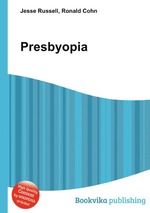Presbyopia
Jesse Russell Ronald Cohn
бумажная книга
High Quality Content by WIKIPEDIA articles! Presbyopia is a condition where the eye exhibits a progressively diminished ability to focus on near objects with age. Presbyopia’s exact mechanisms are not known with certainty; the research evidence most strongly supports a loss of elasticity of the crystalline lens, although changes in the lens’s curvature from continual growth and loss of power of the ciliary muscles (the muscles that bend and straighten the lens) have also been postulated as its cause. Like gray hair and wrinkles, presbyopia is a symptom caused by the natural course of aging. The first signs of presbyopia – eyestrain, difficulty seeing in dim light, problems focusing on small objects and/or fine print – are usually first noticed between the ages of 40 and 50. The ability to focus on near objects declines throughout life, from an accommodation of about 20 dioptres (ability to focus at 50 mm away) in a child, to 10 dioptres at age 25 (100 mm), and levels off at 0.5 to 1 dioptre at age 60 (ability to focus down to 1–2 meters only). The expected maximum and minimum amplitudes of accommodation for a corrected patient of a given age can be determined using Hofstetter`s formulas: Expected amplitude (D) = 18.5 - 0.3 x (age in years), Maximum amplitude (D) = 25 - 0.4 x (age in years), Minimum amplitude (D) = 15 - 0.25 x (age in years).


